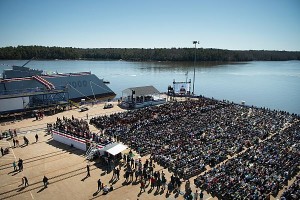 Love the DDG-1000 or hate it, supporters of America’s multi-billion dollar “battleship-as-destroyer” program have largely been–up to now–quiet on the sidelines of Washington’s unseemly post-Sequestration budget scrum.
Love the DDG-1000 or hate it, supporters of America’s multi-billion dollar “battleship-as-destroyer” program have largely been–up to now–quiet on the sidelines of Washington’s unseemly post-Sequestration budget scrum.
In the vast array of American defense programs desperate to avoid closure, an old survivor like DDG-1000 (previously known as the arsenal ship, the DD(X), etc., etc.) has been conspicuously low profile. That relative silence (intricate Christening ceremonies and fawning press treatments aside) left many DC observers thinking that General Dynamics would be content to let the program quietly die off after three hulls.
Too many informed DC folks wrote the DDG-1000 off. They explained the DDG-1000 away as a modern analogue of the one-of-a-kind super-expensive Norfolk Class DL-1, a ship that spent most if it’s life as a technical demonstration platform. Others saw the DDG-1000 program as more akin to the 4-hull, somewhat experimental Mitscher Class (DL-2). Others pointed at the three-boat Seawolf (SSN-21) Program. All of these were high-cost, high-tech programs that ended quickly.
Conventional wisdom held that DDG-1000 was–after it’s 2009 cancellation–merely an experiment, saved from outright elimination just to keep the Marine Corps from harping for another decade about the lack of naval surface-fires.
To bend a phrase from a London socialite’s description of a washed-up, post-World War I Winston Churchill, the conventional DC line for this program was, “Oh, the DDG-1000? It’s finished.”
They were wrong.
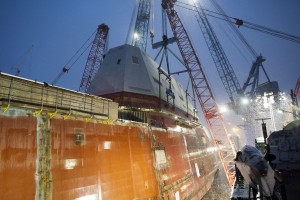 It is starting to look like General Dynamics is going to fight for the DDG-1000 production line–frankly, it’s a battle General Dynamics must wage. They’ve invested far too much in Bath–making far too many DDG-1000 specific yard improvements to even consider stopping the DDG-1000 production line at three hulls. Canceling DDG-1000 is corporate suicide.
It is starting to look like General Dynamics is going to fight for the DDG-1000 production line–frankly, it’s a battle General Dynamics must wage. They’ve invested far too much in Bath–making far too many DDG-1000 specific yard improvements to even consider stopping the DDG-1000 production line at three hulls. Canceling DDG-1000 is corporate suicide.
Personally, I’ve been expecting some sort of fight for the DDG-1000 from the moment Fred Harris–a program expander “par excellence”–was moved from NASSCO to lead Bath into the future. And I guess, now that the three Program of Record ships are safely awarded, Huntington Ingalls is out of the program and the first hull is set to start builders trials, the long-expected battle is upon us.
The first shot in the upcoming battle for DDG-1004 was fired in a January issue of National Defense Magazine from Third Way scribe, Ben Freeman, Ph.D.. His op-ed, “Canceling the DDG-1000 Destroyer Program Was A Mistake“, summed up the latest strengths inherent in the “offensive” DDG-1000 design, attacking the merely “defensive” Flight III DDG-51.
Here’s the relevant bit:
All of these comparisons between DDG-51s and DDG-1000s belie the fact that the ships should not be competitors; they serve different, but complementary roles that are both essential for the future of the U.S. Navy. Fortunately, it’s not too late for Congress to act — the DDG-1000 production line is still hot. If we’re serious about having a Navy that can adapt to the threats of tomorrow, then we need to get serious about DDG-1000’s today.
It’s a classic–and rather nicely done–pay-for-platform-advocacy piece.
Ben plies his trade well, damning the DDG-51 with faint praise. He talks up the DDG-1000 gun (while waving away magazine-size concerns with some “endless magazine” VERTREP-while-firing scheme), the DDG-1000’s big flight deck, the DDG-1000’s power-generation capability vs. current consumption, the small crew size, the available margin…banging away at a “DDG-1000 beats DDG-51 Flight III” theme.
The next shot came at last week’s naval hearing at the Senate Appropriations Committee. I was particularly struck by a question from Bath Ironworks’ Senator Susan Collins, where she asked CNO Admiral Greenert to detail the advantages of the DDG-1000.
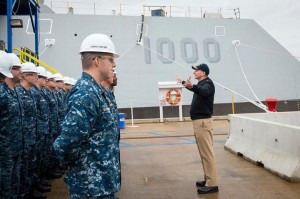 CNO Admiral Greenert, in a fresh-faced “I’m not really running to be Chairman of the Joint Chiefs” performance, didn’t disappoint. He flashed his rarely-seen-by-staff “aw-shux” grin of an avuncular uncle, leaned into the mic, and sung the DDG-1000’s praises:
CNO Admiral Greenert, in a fresh-faced “I’m not really running to be Chairman of the Joint Chiefs” performance, didn’t disappoint. He flashed his rarely-seen-by-staff “aw-shux” grin of an avuncular uncle, leaned into the mic, and sung the DDG-1000’s praises:
Firstly, as you said, the cruise is one-third, so that’s about 150 versus the cruiser of today close to 450 right off the bat.
It has enough power to — ah, the power required to run the ship and all its systems is only 50 percent of the capacity of the ship, so this thing can grow as we get more payload. It has tremendous growth.
It’s radar-evading, as I say. It’s stealthy. So it — it’s a — on radar, it looks about the size of a tugboat, you know, if you would imagine. And then, of course, there’s an acoustic element. If ah, you’re under the water and you’re listening to it, it does not sound like a cruiser or a destroyer. It sounds like a very, very small craft [editor’s note: Check out the video of the testimony–the expression on the old submariner’s face here is hysterical]. So there’s another evading piece.
It has a tremendous missile — cruise missile capability, anti- air capability. It has a dualband radar. That means it can track anti–uh ballistic missiles while protecting itself from cruise missiles that that dual-band has a gun that goes twice as — three times as far, about — right now about 70 miles versus the best we can do today is about 15 miles, so that’s five times — excuse me. It goes on, Senator.
This thing is a quantum leap in capabilities.
For those of us who have been around the rodeo for awhile, that set-piece was a shot heard ’round the world. A Senator like Susan Collins (R-Bath Ironworks) only asks these types of questions-for-the-record if she has been told to ask it.
By a big constituent.
Like General Dynamics.
I don’t quite know what the battle lines in this fight for DDG-1004 will be.
Obviously, DDG-1000 supporters will point to plans stating that all the ships will operate in the Pacific, making contributions on the front lines there.
Then there’s the pricetag. We are already seeing how the high cost of the DDG-51 restart is being used to make the DDG-1000 look far more palatable.
Frankly, the timing is right to use DDG-1004 to take a big bite out the Flight III DDG-51 program. The Flight III DDG-51 is going to be a mess–rather than asking the tired old DDG hull to do more with less (i.e. design a lower-cost DDG-51 Littoral variant), the hull is being asked to do more with…more. There’s just not enough room left in the DDG-51 hullform for all the fancy high-end stuff the Navy wants–I mean, when the Navy is sacrificing hangar-space for an extra generator, that’s…well…not a great tradeoff.
(It’d be far more worthwhile to try and close out the DDG-51 line with a rough-and-tumble low-end variant. Instead, the Navy is consuming every bit of the DDG-51’s margin for high end sensors…that the legacy destroyer can now barely carry.)
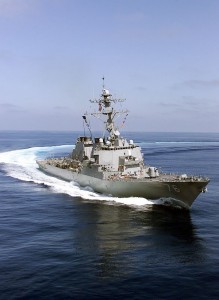 So…in comparison to a cramped, no-margin missile-defense DDG-51 Flight III, extending the DDG-1000 production run might not be a bad thing.
So…in comparison to a cramped, no-margin missile-defense DDG-51 Flight III, extending the DDG-1000 production run might not be a bad thing.
And then, for General Dynamics, there’s the added advantage that Huntington Ingalls can’t complete for DDG-1000 like the DDG-51. They’d never get the price low enough to win.
Is DDG-1000 A Winner?
I don’t know yet.
Extending the DDG-1000 may well be a better long-term investment for the Navy than a refresh of the DDG-51 line.
Don’t get me wrong–I’m concerned that the DDG-1000’s small crew (slightly bigger than a LCS) will be overwhelmed by the DDG-1000’s vast warfighting responsibilities, that the DDG-1000’s none-too-hefty missile arsenal is unable to be replenished outside of port and that, well, the ship is just too big to be survivable in modern combat…but…at least there’s room enough in the ship to try and fix those problems with some kind of refit…or newbuild (cough CG(X) cough cough) re-design.
Personally, I had seen the big, beefy and “redesigned-to-get-the-kinks-out-and-price-down” LPD-17 as a potential low-end competitor for the DDG-1000. But now that the LPD-17 follow-on is being competed–between GD/NASSCO and, essentially, Huntington Ingalls, I suspect General Dynamics may win and, in essence, take over that hull–eliminating a potential lower-cost DDG-1000 competitor. We shall see. But with the DDG-1000 going head-to-head–and likely beating the DDG-51 restart…without an LPD-17-esque hull, there’s no competition for the big surface combatant niche.
But I’m also beginning to wonder if spinning off variants of existing hullforms offers better value than, say, embarking upon another clean-sheet newbuild combatant. American newbuilds don’t have a good record–The U.S. needs years to work through all the kinks. On the other hand, America’s refits and variants enter the fleet far, far faster, for far, far less. So it may be the right time to bite the bullet, and learn to love the DDG-1000 despite the platform’s inherent structural and operational flaws.
Finally, I think there’s also a cautionary lesson somewhere in all of this–the Seawolf Class SSN. The Seawolf was cancelled as being too expensive for the post-Cold War world. But the replacement, the Virginia Class SSN, offered less and ended up costing about as much (and–looking at the costly SSBN(X) I’ll be willing to bet we could have found a way to cost-effectively cobble a few ballistic missiles into a Seawolf hullform if the Seawolf was still in production, as well). So, rather than kill the DDG-1000 at three hulls, let’s take all the work that has been done to set up a production facility, all the work that has been put into developing a serviceable platform, with, by all reports, pretty good HM&E, and start taking a look at what a DDG-1000 Flight II might be. Who knows? It might just be the ship America needs.
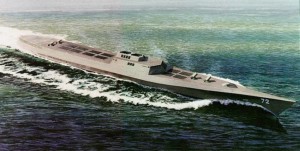
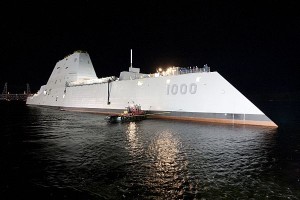

{ 22 comments… read them below or add one }
Why not the DDG-1000 and having a cruiser version? Builds on time, very revolutionary. Is it so bad to have something that basically worked in a reasonable fashion compared to LCS or F-35’s in terms of performance or cost overruns? One platform besides the new carrier that seems perfect for the new type of weapons that the US needs to deploy aka energy weapons.
There was originally a cruiser version planned to be based off of the DDG-1000, But after that was cancelled so was the cruiser, Cruiser version would have been (maybe will be?) 20-25,000t+.
Would like to see it happen, the ship really is a amazing and after the initial blasting of it by the normal pundits, it really is revolutionary. In a day and age where power generation and costs due to headcount seem key issues, this ship seems to fill the ticket. One can hope anyway…
Excellent article with one exception: what are the referenced “inherent structural and operational flaws”?
Reverse tumble-home hulls have less reserve buoyancy, and are thus more susceptible to capsizing in certain sea conditions. Battle damage exacerbates that effect.
Reasonable point, long recognized and analyzed by the Navy. It comes down to a tradeoff between reduced signatures to avoid or dramatically reduce the probability of successful attack, and some well studied and understood ship operating constraints. It will be interesting when DDG1000 gets to the fleet and they begin to understand how to use a stealth ship to tactical advantage.
Meanwhile, Navy admits DDG-1000 running a year late. http://gcaptain.com/zumwalt-destroyer-deliveries-running-year-late-u-s-navy/
Makes sense to me. But for Zumwalt to live, something else will have to die. Merely calling a halt to the revival of DDG51 will not be enough.
Hmmmm. (I am thinking.) I’ve got it.
As others have noted, the LCS is a useless ship in both its variants. The juxtaposition of the two programs in question presents a clear choice. The recent revisions of naval surface warfare doctrine that justify the DDG1000, render the LCS obsolete and superfluous. Think “distributed lethality”. Which ship comes to mind ?
LCS must go and well it should. For a replacement, choose proven but less expensive vessel capable of being a frigate: a beefed up version of the next CG Offshore Cutter.
Repeat after me: “The Navy’s smallest warship is the Coast Guard’s largest vessel.”
I’m gonna to sorta skip over the merits of the Baseline ZUMWALT, other than to say the Navy will find work for a handful of Littoral BattleCruisers even if the LCB configuration isn’t main reason the class deserves to continue. If we need to build 6 or 9 or a dozen to bridge the production line to an IAMD-focused Flight II, those hulls will not go unused.
I completely agree with Ben Freeman that the Radar/Hull study was troubled. Although left out of the study’s title, it appears that one of the biggest factors given weight in the decision was actually the Computers. Specifically, it seems that the software work needed to put the TSCE-I combat system on par with Aegis BMD put decision-makers off and they decided to just stick with Aegis as long as possible. A classic can-kick, and one I worry that has as much to do with the name “Aegis” as the actual program. Maybe if Raytheon had been able to label their combat software as “Aegis 2” (Electric Boogaloo), or if Lockheed had won that work rather than Raytheon, the outcome would have been different.
Whether or not a ZUMWALT Flight II with AMDR and rails/lasers/etc ever happens or not, I really hope that this time, finally, the Navy is learning how bad idea it is to say “hey we can worry about what more we would do with this hull later, let’s just focus on now.” People point at the Danish navy and say “see, we need to buy Absalons” or “see, building to commercial standards isn’t so bad.” But they should really be saying “See, this is how you share a hull.” IVER HUITFELDT and ABSALON both have compromises to make it work, but on the whole the arrangement has come off really well because they planned it and executed it right. And they could even be going further, had they the money they could spin off an ASW frigate and a Mothership class without too much difficulty.
Good one!
Last I heard, the Flt III DDG-51s won’t have to put another generator in the hangar. Instead, they will use upgraded versions of the existing generators to add power.
This is true. However, they also have to add a rather beefy glycerol system to keep the AMDR cool. A few of the Officers’ berths had to be moved up to the 01 level, next to the hangar, to make room.
Thanks Beomoose. Correct me if I am wrong, but the early iterations of flight three there was talk about a “generator in the hangar”, yes? Don’t know if that was just talk before the real engineers had a chance to work things over, but I think it was a solution offered at an early stage…either way, not a great place to start horse-trading…
Yeah they hunted around for solutions to the power problems and that was among the options explored. In a fit of irony, they were bailed out by the MT-5 from the ZUMWALT program. They have been able to swap out the 450 VAC SSGTGs and in their place mount the 4160 SSGTGs from the 1000.
Jokes aside, there are good points made here – especially about the Seawolf. If the DoD (especially the Navy) could just be upfront and honest about first-in-class ship costs, they’d be able to ride out the inevitable criticisms and problems more readily. DDG-51 Flight III is going to be a nightmare – and wait til Dr. Gilmore gets his hands on an AMDR ship to excoriate as being less capable than advertised.
The problem is that I think the real thing that could tip the scales would be a rail gun, high-energy laser weapon, or some other technology that simply can’t fit on a DDG-51 in terms of SWaP – no matter how modified that hull may be. Unfortunately, with the Navy only just floating the idea of a railgun test on the DDG-1002 several years from now, the moment may have passed. . . . this decision would have to be made in the next 1-2 years, and I’m not sure the politics or the budget & service issues will be resolved enough by then to allow for this.
Great comment! What do you think about the potential for shrinking some of those high-energy weapons “to fit”? Possible, yes?
Craig – did you really end up in DC? .. I am happy to sit down and explain why Ash Carter’s work on laser lethality in the 1980s is ageless. As to contamination control, you Navy guys ought to consider that shipborne environments where you get green water over the bow might not be ideal places to put big optics that self-destruct with a salt fog spot. Finally the problem of pushing a high energy laser through fog, spray, rain, dust, smoke is summarized as “NO you can’t”.
Exactly! The second issue that incoming missiles refuse to sit still for two seconds so a laser can burn through its housing. They bounce around several feet while inbound due to wind turbulence and continual course corrections. This is an accidental countermeasure that CIWS has trouble with too. A far better option for shore or ship attack are Navy C-40s (B-737s) with cruise missile or bombs. http://www.g2mil.com/bm747.htm
AMDR is a means to address the innate limitations of AN/SPY in high threat environments. Based on the backfit requirements (same deckhouse, same prime power) the peak power isn’t where the SPY +15 comes from; the whole increase is average power thus the AMDR will degrade less when subjected to combat environments. The Aegis BMD fan-boys should calm down and realize the point of a flexible asset is to accomplish multiple missions not to serve as an expensive barge tied to a geographical point for a BMD mission we hope to avoid. Seriously, SM-3 should be put on barges but that gets into mission optimization issues.
As to the laser and rail-gun fan club, don’t leave home in DC – its the only local place where you get to smoke the recreational drugs necessary to harbor expectations of those ever becoming useful weapons. Lasers are pretty pathetic, we spent 8 billion learning why they aren’t effective weapons and the rail-guns are looking at a solid decade plus of guided projectile R&D before anyone wants to put them in front of a real AoA v real guns.
With just one ship builder, perhaps only one Flight II DDG-1000 would need to be started every other year (FY2017, 19, 21, 23) to keep production going. Funding could come from reduced LCS purchases and a couple fewer Flight III DDG-51s. New technology, such as rail guns and lasers, ASuW missiles, UAVs/UUVs, etc. could be introduced during that time. Then, around 2025 use the proven, risk-reduced DDG-1000 hull and systems for the CG(X) with a 21-foot AMDR or better radar (vs 14-foot max size on DDG-51) and whatever the state of the art IAMD weapons are at the time to begin replacing the CG-47s. Not only will they be way better at IAMD, but much better at ASW and ASuW (harder to detect, better able to use energy weapons and other new systems due to space/weight/electrical margin) compared to even a Flight IV Burke while being cheaper to operate (with much fewer crew). FYI, here is an update to Congress on the DDG-51 Flight III: http://news.usni.org/2015/03/04/document-navy-report-to-congress-on-flight-iii-destroyers
Worth pointing out the fourth DDG-1000 will be DDG-1003, not -1004?
Late-night, post-work, post-baby posting gets ya every time…